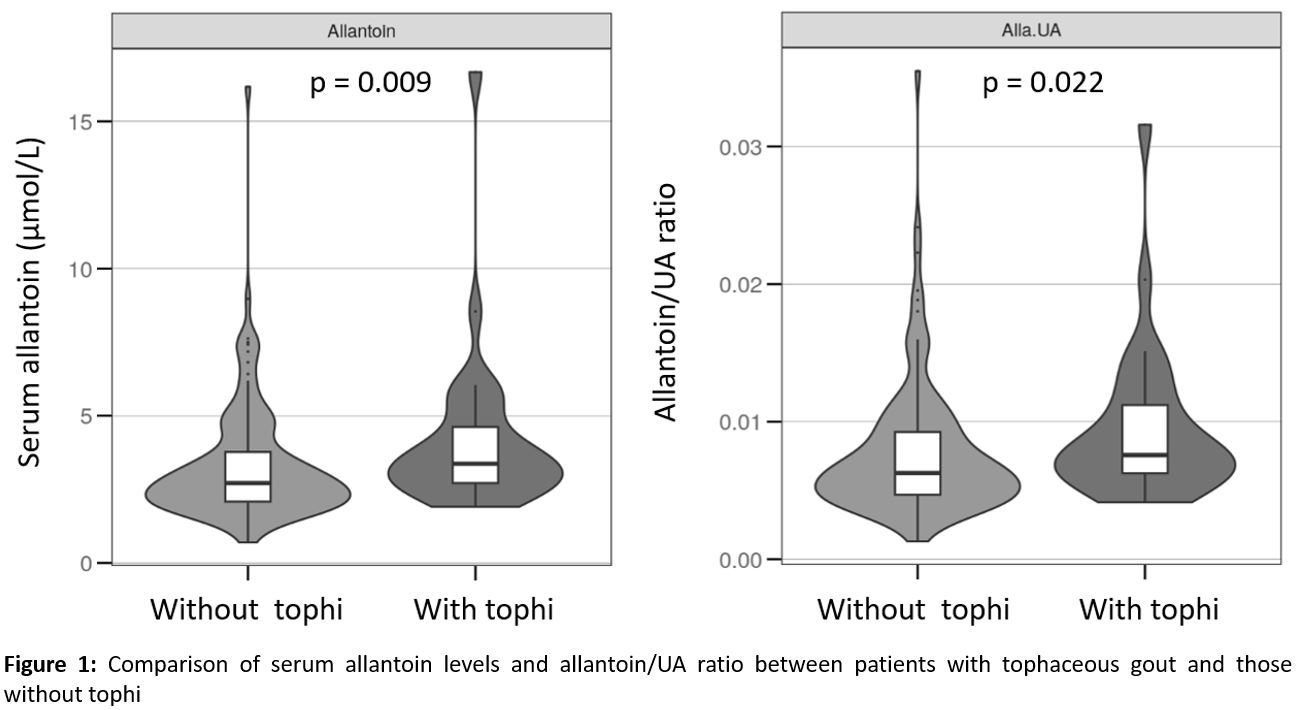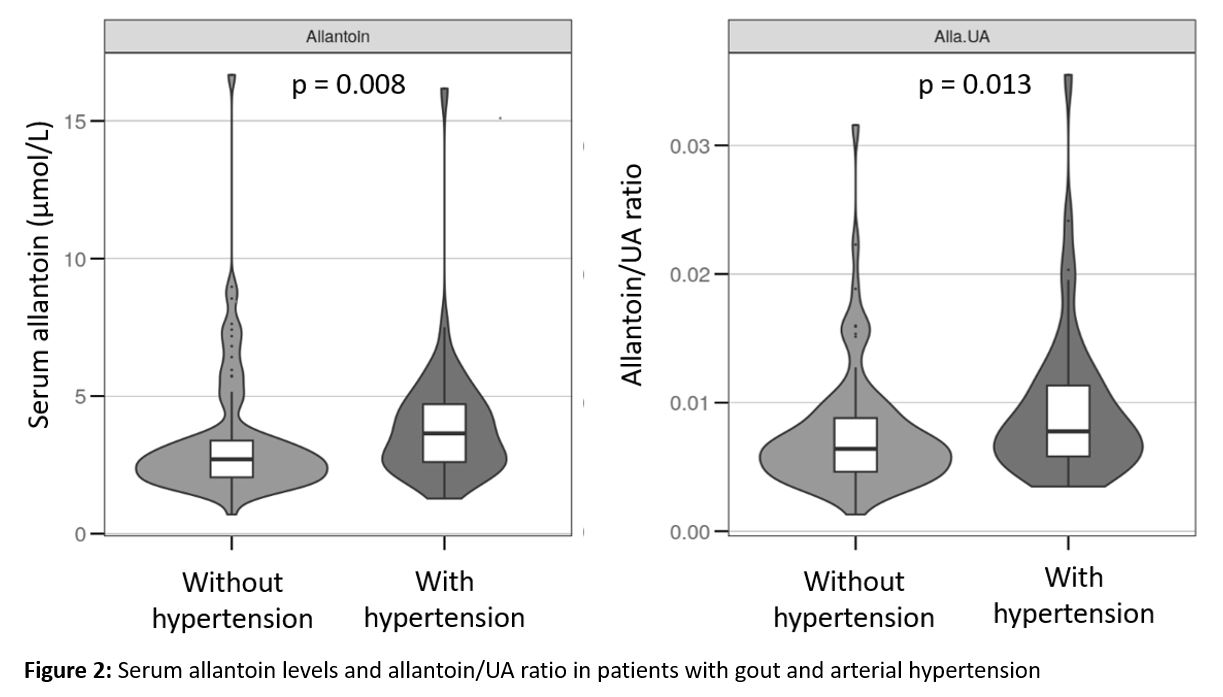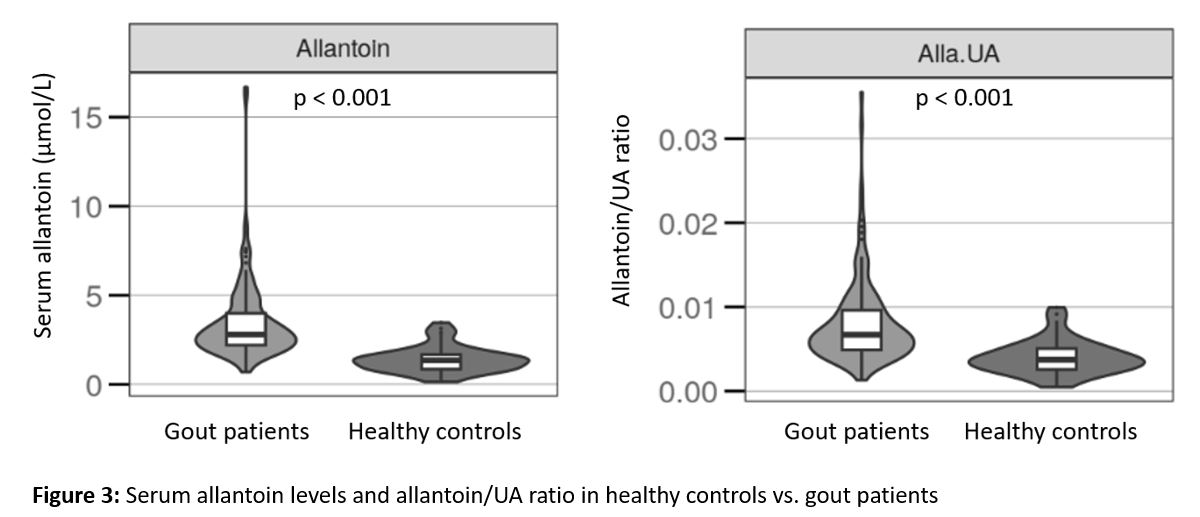Session Information
Date: Monday, November 18, 2024
Title: Metabolic & Crystal Arthropathies – Basic & Clinical Science Poster III
Session Type: Poster Session C
Session Time: 10:30AM-12:30PM
Background/Purpose: Uric acid (UA) can be non-enzymatically oxidized into allantoin and other products by reactive oxygen species under conditions of increased oxidative stress. Consequently, allantoin has emerged as a reliable biomarker for assessing oxidative status both in vitro and in vivo. The aim of this study was to measure allantoin and allantoin/UA ratio in patients with gout and to investigate whether these levels are higher in patients with more severe disease (tophaceous gout, presence of gouty attacks) or in patients with cardiovascular comorbidities (arterial hypertension, diabetes, dyslipidemia).
Methods: Clinical data and frozen serum samples were obtained from 154 patients with gout and 47 healthy controls. Allantoin levels in serum were determined using UHPLC-MS/MS1. In addition to allantoin levels, the allantoin/UA ratio was calculated. Serum concentrations of CRP, creatinine, UA, and lipid profile were also measured. Data are presented as medians with interquartile range [IQR]. Differences between groups were evaluated using the Wilcoxon signed-rank test. Pearson correlation coefficient was used to correlate log-transformed values with log-transformed CRP.
Results: Serum allantoin and the allantoin/UA ratio were significantly increased in patients with tophaceous gout compared to those without tophi (3.37 [1.91] vs. 2.71 [1.69], p = 0.009, and 0.008 [0.005] vs. 0.006 [0.005], p = 0.022) (Fig. 1). In patients who reported a gouty attack within the last five years, allantoin levels were significantly elevated (2.90 [2.11] vs. 2.62 [1.37], p = 0.05), showing a slight upward trend with the number of attacks. Patients with gout and concomitant arterial hypertension exhibited significantly increased levels of allantoin and the allantoin/UA ratio (3.65 [2.11] vs. 2.70 [1.34], p = 0.008, and 0.008 [0.006] vs. 0.006 [0.004], p = 0.013) (Fig. 2). No significant differences in allantoin or the allantoin/UA ratio were observed in patients with gout and other comorbidities (diabetes, dyslipidemia). Healthy controls had significantly lower levels of allantoin and the allantoin/UA ratio compared to gout patients (1.35 [3.32] vs. 2.8 [15.97], p < 0.001, and 0.004 [0.003] vs. 0.007 [0.005], p < 0.001) (Fig. 3). Allantoin and the allantoin/UA ratio were positively associated with CRP (r = 0.351, p < 0.001, and r = 0.295, p < 0.001).
Conclusion: We observed significantly elevated levels of serum allantoin and the allantoin/UA ratio in patients with more advanced gout characterized by the presence of tophi and in patients with gout and arterial hypertension. Patients who experienced a gouty attack within the last five years exhibited significantly higher levels of allantoin. The level of allantoin correlated with disease severity, as indicated by the presence of tophi, gouty attacks, and arterial hypertension. These findings suggest that higher levels of oxidative stress may contribute to increased cardiovascular risk and mortality in patients with gout, particularly in those with severe disease.
Supported by: Ministry of Health, Czech Republic (NU22-01-00465, 023728).
References:
1. Kozlik P et al. Anal Biochem. 2020;589:113509
To cite this abstract in AMA style:
Hasikova L, Kozlik P, Kalikova K, Dusek P, Pavlikova M, Stiburkova B, Závada J. Elevated Serum Allantoin and Allantoin/uric Acid Ratio as Indicators of Oxidative Stress in Severe Gout and Cardiovascular Comorbidities [abstract]. Arthritis Rheumatol. 2024; 76 (suppl 9). https://acrabstracts.org/abstract/elevated-serum-allantoin-and-allantoin-uric-acid-ratio-as-indicators-of-oxidative-stress-in-severe-gout-and-cardiovascular-comorbidities/. Accessed .« Back to ACR Convergence 2024
ACR Meeting Abstracts - https://acrabstracts.org/abstract/elevated-serum-allantoin-and-allantoin-uric-acid-ratio-as-indicators-of-oxidative-stress-in-severe-gout-and-cardiovascular-comorbidities/



